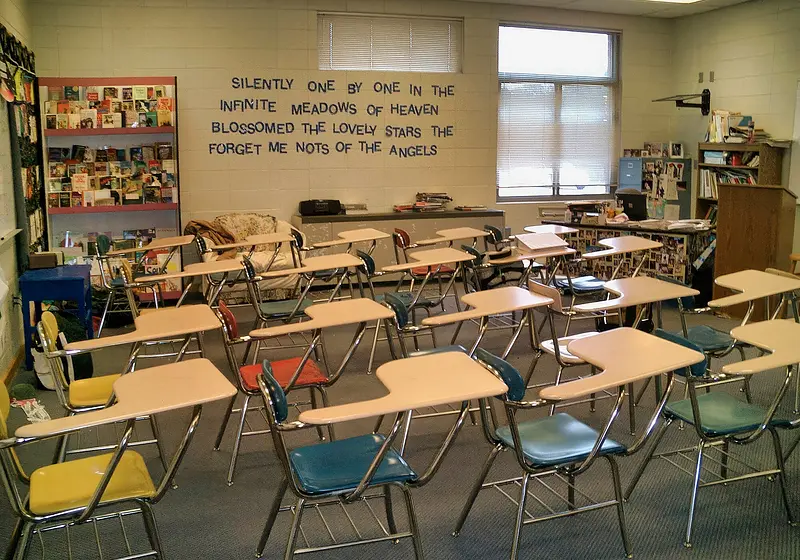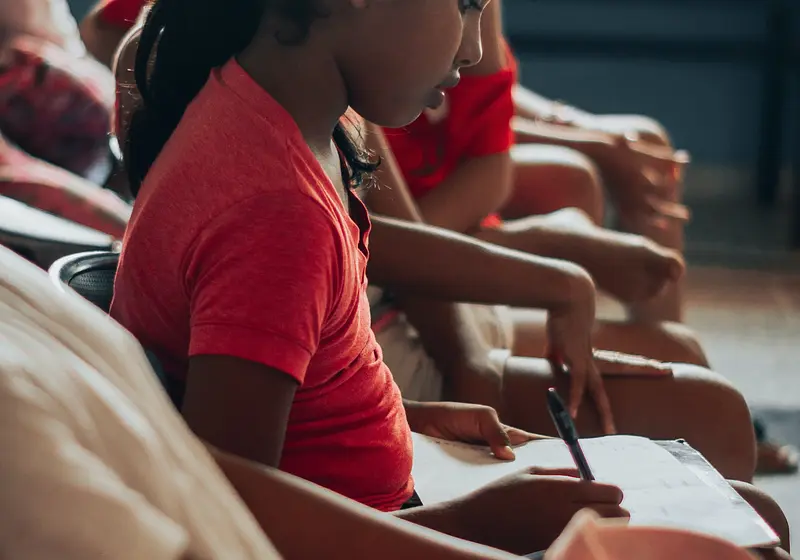TRIGGER WARNING: mentions of suicide, depression, self-harm
Most students can relate to a parent or some other adult guardian asking this question at some point: "What did you learn in school today?" I know I do, and I know that I'm not just speaking for myself when I say that typically, I can't recall much. On the surface, this may sound like the fault of the student for being inattentive and lazy. I mean, why wouldn't you remember what you learned at school?
You spend 5 days a week there for six hours, you should be able to retain some of the information given to you. However, this phenomenon is more common than you think, with students forgetting 50% of what they learned in the first hour after the information is presented, and 70% after the first day, according to an article by Indegene.com.
This fact, along with many others such as the COVID-19 pandemic, which had an immense impact on the education of the American youth, are reasons why the American education system is falling short of excellent. With test scores reaching a new 30-year low, thousands of teachers leaving, and racial disparities, this article will attempt to address the issues causing one of the richest countries in the world to have a failing school system.
The Unexpected Impact of COVID
March 13, 2020. The beginning of lockdown, mask mandates, and what would be an emotional rollercoaster for not only the citizens of the United States but the world as a whole, especially its most vulnerable—children and teens. At the beginning of the COVID-19 pandemic, we were all sent home from school for what we thought would be a mere few weeks.
Somehow, those few weeks turned into months, and as time progressed and the virus spread and worsened, it snowballed into a year. We had to say goodbye to our friends and teachers and hello to Zoom meetings, and online tests.
However, no one quite anticipated or understood the magnitude of the severe damage that the virus would have on students. A 2022 study done at Brown University examined the test data taken from three COVID-19-impacted years—2020, 2021, & 2022. The study’s results showed that math and reading achievement goals reached a steady decline during the first two years of the virus, and have struggled to recover post-pandemic.
Unfortunately, the impact of COVID didn’t just stop at low test scores and poor classroom performance. According to a study done at Stanford University, the pandemic severely worsened the mental health of adolescents aged 13-17. The results of the study were,
“The sample consisted of 163 adolescents (aged 13–17 years) in San Francisco, California, who were participating in a larger longitudinal study. Half were assessed before the COVID-19 pandemic, and the other half were assessed after stay-at-home shutdown orders were issued in March 2020. The two groups differed significantly in both their mental health and brain development. Compared to the pre-pandemic group, adolescents assessed after the pandemic shutdowns reported more symptoms of anxiety and depression and greater internalizing problems.“
With all of these negative effects on your psyche, especially at such an integral part of your development as a person, it makes sense that in turn, it would be extremely difficult to readjust to a normal academic setting. This is something many students across the country and the world had to face when coming back to school during the 2021-22 school year. To analyze the weight of the pandemic’s effects, we need to look at how education changed after COVID-19.
Let us slide into your dms 🥰
Get notified of top trending articles like this one every week! (we won't spam you)Returning to School: What’s Changed?
Since coming back to school post-pandemic, I’ve noticed a shift—the energy feels off. The same energy and excitement, and light that used to fill the hallways has become dim. Students aren’t as excited to learn, and teachers are losing motivation with complacent students and lack of support from their districts and administrations.
Between February 2020 and May 2022, over 300,000 public school educators left the profession, according to the Wall Street Journal. Many teachers have reported feeling “stressed,” “burned out” and “unsupported” by the lack of help they’ve been receiving. This case isn’t any different for a New Jersey public school teacher, whom I had the chance to interview for my article.
When asked what major issues she faced in her home school district, she reported classrooms always being at full capacity, which makes it difficult for teachers to give students the proper amount of attention needed, especially in classes with special education students.
“So currently, in all my classes I have about 24 to 25 students. I teach in an inclusion classroom. For those that don't know what an inclusion classroom is, an inclusion classroom is a classroom with special education and general education students, so having a classroom such as an inclusion classroom, with 24, to 25 students, it's very concerning, and makes it almost impossible to have enough time or the needed time for special needs students in the classroom," the teacher recounted.
She went on to address concern for lack of academic readiness.
“I just believe that some students are just being transitioned from one grade to the next. And I feel like some of the students are not ready, because maybe they failed some classes and they needed to be repeated. But they were just transitioning to the next class or the next grade.”
This shows the amount of stress teachers go through while teaching, and the lack of support from school districts. Aside from these glaring issues preventing teachers from properly doing their jobs, there's one issue that's exacerbating all the others: a flawed curriculum.
A Broken Curriculum
The US education curriculum has issues. That's no secret. As a person, it's obvious, but as a student, it's frustrating---we spend just as much, if not more time in school than we do at home, and we spend that time learning things the same way the generation before us did.
This leads me to a major issue with the curriculum in the US: outdated teaching methods. There's a lack of innovation in teaching. Times are changing and students are struggling, so why aren't we adapting?
The Common Core curriculum is the curriculum used in the US education system, and it set English and math standards in 41 states for grades K-12.
Adopted in 2010, the initiative attempted to refine education standards in the United States and resolve concerns from parents. However, 13 years after its implementation, it has fallen short; in addition to being out of date, the standards aren't enough to prepare students, especially ones in secondary school, for higher education.
Seven years after the adoption of Common Core standards, test scores in math and reading had plummeted in the US, according to a study published by the Pioneer Institute. Common Core is a system that refuses to change.
In an age of children heavily impacted by the COVID-19 pandemic, the Common Core curriculum hasn't adapted to fit the needs of the new generation of learners, which is problematic in itself for the reason that our kids are the future, and without a quality education foundation, how can we expect them to go to college, let alone be productive members of society?
These issues are big for any student, but the groups that they affect the most are students in marginalized communities, which leads to my next point, lack of diversity in education.
Lack of Diversity in Education
Most teachers are white, and a lot of students aren't. We've made great strides in diversifying our classrooms in the past 30 years, but those strides aren't enough to accommodate the amount of POC students. According to a 2018 US census report, 49% of the US population is projected to be members of a racial minority group by 2045. The current lack of representation in education is problematic because students need to be able to see themselves represented not only in classroom material but also in those teaching the material to them. According to Zippia, “The most common ethnicity among teachers is White, which makes up 68.8% of all teachers. Comparatively, 12.9% of teachers are Hispanic or Latino, and 10.1% of teachers are Black or African American.” This is in comparison to Statistica's data which states that nationwide, "45.2 percent of K-12 public school students were White, 14.9 percent were Black, and 28.4 percent were Hispanic."
The solution to this issue sounds simple--hire more racially diverse teaching staff, but that's a lot more of a complicated solution than you might think. Many teachers of color report workplace discrimination and low pay, resulting in some leaving the profession of teaching entirely, so just “hiring more POC teachers” isn't quite an easy fix.
To be able to hire more diverse staff, the administration needs to create a welcoming atmosphere for POC teachers to feel safe and accepted working there, and minority students easily pick up on the fact that there aren't many teachers like them, speaking from experience where I didn't have my first Black teacher until my freshman year of high school. Speaking of students, let's address student behavior and mental health since they're just as important in creating a positive teaching experience for educators as anything else.
Student Behavior and Mental Illness
Teachers aren't the only ones feeling stressed. A 2015 NYU study revealed that almost half (49%) of all students surveyed reported feeling a great deal of stress daily and 31 percent reported feeling somewhat stressed. This stress has caused high levels of depression and anxiety in teens. Research from the CDC revealed that in 2021, 29% of high school students experienced poor mental health during the past 30 days.
This issue has led to suicide being one of the leading causes of death among adolescents aged 15-19, as well as many teens struggling with self-harm. Mental health issues are hard to deal with already, but when you're a teenager, it's even more difficult when you have to balance school, family, and extracurriculars.
Aside from teenagers struggling with mental illness, many students have a lack of motivation, leading many students to feel apathetic and teachers at a wit's end on how to make their students love learning again. With all the issues plaguing our education system, it's easy to wonder how other countries, especially in Europe, compare to the United States.
America vs. the EU
European countries such as Sweden and Finland have been hailed for having some of the best public education systems in the world, but what traits about this education style have gained such praise? For one, European countries put less of an emphasis on traditional post-secondary education than the United States.
In the US, college admissions isn't only something students are conditioned to aspire to--it's a business. According to the Education Data Initiative, the average American is in $37,718 worth of debt.
This business exploits students' desperation and societal expectations to get a diploma and causes immense stress. In contrast, European education explores and even prepares students for other options such as vocational or trade school, and for those who seek a traditional education, many public universities in the EU are free.
Europe doesn't use the Common Core curriculum and instead has a refined system that has led to having one of the lowest premature dropout rates in the world. European education systems are also heavily student-centric and give students a lot more autonomy over their education.
The atmosphere in countries such as Denmark and Sweden also leads to increased life satisfaction and overall happiness, leading to lower rates of depression & anxiety and lower stress in all areas of life, including academics.
For these reasons, the EU is leading in education because it exceeds in all the areas in which the US is lacking. The US's lack of innovation and unwillingness to change is ultimately hurting it and the children in its public school system, but it doesn't have to. Here's what I think the future of the US education system holds for this generation and the ones after it.
Final Thoughts
Education is a pillar of everything and is a gift. With the current state of American education, we are robbing our children of that gift to know things and to bestow knowledge onto others. We need change and reform, or else we will continue to fall behind. We may be broken as an education system right now, but for the sake of our children, we can't be forever.
Our future is in the hands of the government to say something and change the current narrative being set. We have a generation of future change-makers sitting before us now with so much potential, so not only as a citizen but as a student, I ask for it not to go to waste.











.jpg)



